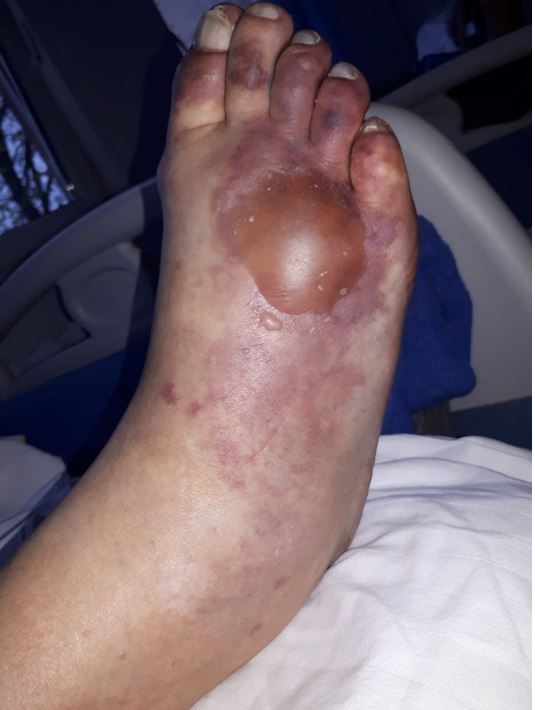
SciBase Journals
SciBase Clinical and Medical Case Reports
ISSN 2995-5874
- Article Type: Clinical Image
- Volume 2, Issue 1
- Received: Feb 12, 2024
- Accepted: Mar 22, 2024
- Published Online: Mar 29, 2024
From Hypothyroidism to Stroke … Is it Such a Short Way?
Anca M Belu1,2*; Melina M Iordache A2; Daniela M Belu2; Eduard Circo1,2; Cristina Dobrin1; Alina D Nicoara1,2
1Constanta County Emergency Clinical Hospital, Sf. Apostol Andrei, Bd Tomis 145, Constanta, Romania.
2Ovidius University of Constanta, Faculty of Medicine, Campus, Aleea Universității, Corp B, Constanta, Romania.
*Corresponding Author: Anca M Belu
Constanta County Emergency Clinical Hospital, Sf. Apostol Andrei, Bd Tomis 145, Constanta, Romania.
Email: ancabelu@doctor.com
Abstract
Citation: Belu AM, Iordache MMA, Belu DM, Circo E, Dobrin C, et al. From Hypothyroidism to Stroke … Is it Such a Short Way?. SciBase Clin Med Case Rep. 2024; 2(2): 1020.
Description
A 72-year-old patient, known in her personal medical history with essential hypertension, chronic autoimmune thyroiditis and hypothyroidism, undergoing chronic treatment with Euthyrox, shows specific symptoms of hyperthyroidism (palpitations, profuse sweating). After the tests, it appears that the patient has a thyrotoxicosis related to Graves’ disease. Treatment with Thyrozol is initiated. 10 days after the initiation of Thyrozol treatment, a severe neutropenia is noted (0 neutrophils on the peripheral blood smear). It is decided to cease the treatment with Thyrozol and start the treatment with Filgastrim, granulocyte colony stimulating factor and Dexamethasone.
After the administration of treatment, the neutrophils increase to 20,000/mmc, after 3 days of treatment and 11,000/ mmc, 3 days after stopping the treatment. It is decided to discharge the patient, but following the clinical examination, pain and a drop in skin temperature are detected in the right lower limb, a reason why a cardio-vascular surgery consultation is requested. The diagnosis is: non-stenosing diffuse femoral-popliteal atheromatosis, partial thromboembolic occlusion, in the peroneal artery, respectively the mid-distal segment of the anterior tibial artery and the distal segment of the right posterior tibial artery. Initiation of treatment with Clexane 0.6 ml s.c.
The following morning, the patient reports pain in the left clavicle with radiation at the lateral-thoracic level up to the costal margin. Following the imaging investigations (abdominal ultrasound and abdominal-pelvic CT), we note the presence of splenic infarcts and a partially thrombosed fusiform aneurysm at the level of the abdominal aorta in the infrarenal segment.
Subsequently, atrial fibrillation is both clinically and paraclinically detected on the electrocardiogram (probably due to the constantly suppressed TSH). Following the endocrinology consultation, treatment with Propranolol, Propycil, Selenium, Detrical, Clexane 0.6 ml x 2 is initiated.
The evolution at the level of the lower right limb is unfavourable, suffering trophic changes, irreversible stasis ischemia and high intensity pain, which difficultly gives in to Morphine and Tramadol. After several cardio-vascular surgery consultations, it is determined the impossibility of vascular repermeabilization and the amputation of the lower right limb was brought into discussion.
The surgical procedure of amputation of the lower limb is performed. 6 hours after the surgery, the patient suffered an ischemic cerebrovascular accident, as a result of which she developed left hemiplegia and aphasia. The investigation of a possible thrombophilia or coagulation disorders with a genetic substrate, not discussed initially, considering the age, was brought into discussion, but the patient`s family refused the samples collection and requested the discharge, choosing for hospitalization in a palliative care centre.
Particularity of the case: A rare adverse reaction to synthetic antithyroid treatment can lead both directly and indirectly to unfavourable prognosis, life-threatening complications.


